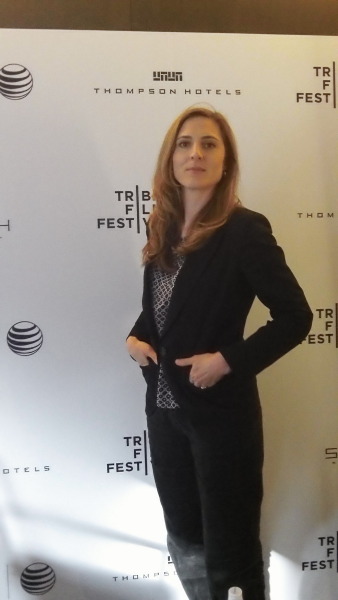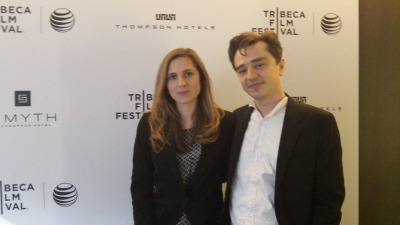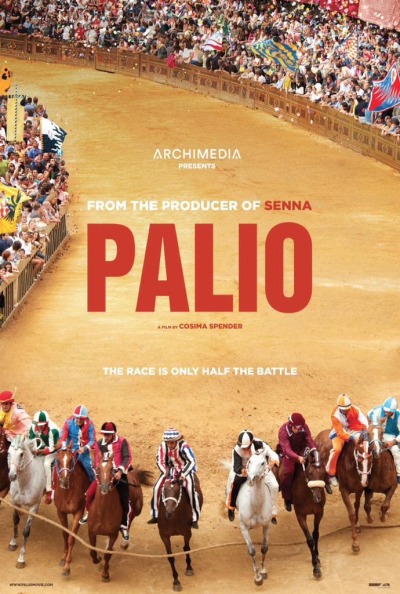 |
| Cosima Spender |
A couple weeks back Hubert and I sat down with director Cosima Spender and her husband and editor Valerio Bonelli to talk about their film PALIO . PALIO tells the story of the centuries old Sienese horse race that is held in the city's main square. Its 90 seconds of excitement preceeded by three days of rituals. The filmis one of the most breathtaking things you’ll ever see. Trust me, when it's done you'll feel who needs CGI car chases or giant robots when you can have PALIO’s horses in a life or death race where the losing jockey can end up beaten half to death? PALIO is one of my favorite films of the year and you must see it. (My review is here. Hubert's review at Ruby Hornet is here)
When Hubert and I saw the film we were both blown away. We both wanted to know more about the race and how it was made. When the chance to do an interview with Cosima came up we jumped. The interview was one of the coolest things I did at Tribeca this year. I’m in heaven whenever I can talk to someone who is well versed and deeply passionate about a subject and as both Cosima and her husband are about the Palio and its history. They also know and love film as Hubert and I found out after the interview when we were comparing notes on the various films at Tribeca. I could have talked with them for several more hours. (Cosima and Valeria if you are reading this and want to do another extended interview let me know I will be happy to sit down with you again)
While I understand that publishing the interview now, with the film still on the festival circuit is not ideal, you may not understand some of the references, I somehow think the passion with which they speak and the subjects that we cover will make you want to see the film and keep it on your radar. You need to be aware that this film is coming because you really do want to see it. And when the film finally gets its wide release you can come back and revisit this interview and get even more out of it.
I want to thank Hubert for helping do the interview and in editing the transcript. And I have to thank Cosima and Valerio for taking the time to talk to us about their really kick ass movie.
STEVE: How did you get interested in doing The Palio?
COSIMA: I was born outside Siena. I grew up there. My mother was half-Armenian/half-American and my father was English. They still live there. I went to the public schools there. I grew up in the countryside outside Siena and then I went to Siena proper to go to school when I was 14. So all my friends were deeply Sienese. They were members of districts. I felt very much an outsider because I wasn't born and raised inside the district. I never really understood it until I wanted to do this as my graduation film from film school, but I was young and inexperienced. I needed a big production behind me to tackle it. It’s a beast of a subject. It’s gargantuan, so I didn't do it as my graduation film
Then I made lots of films for the BBC and here and there. And then after my last film, on my grandfather who was this Armenian painter, I was going "what’s going to be my next project?" I have two children so I can't-- I used to do a lot of films in Africa and around the world but because my life has to be more stable I started to look on my doorstep on a subject. I always wanted to make a film about it and that's how I said "it's time to do Palio."
I started researching. There had been a film that had cinematic release made about ten years ago called the LAST VICTORY which really focused on the districts. I said let’s make a film about the jockeys because no one really looks at the jockeys. I find the whole love hate relationship interesting because I come from anthropology so the whole relationship between the jockeys and the citizens and the city---they need them and they love them if they win but if they lose they are meat to be butchered. I've always been fascinated by this relationship.
STEVE: In the film you see them beating the jockeys, has anyone been killed?
COSIMA: No, no but beaten up a lot. And between the districts it comes from this medieval tradition called Pungna. I went to dinner in one of the districts when I was doing my research and the young men come in and kind of punch each other as a kind of greeting-play fighting. There is a lot of tradition, the fighting is in the DNA. The beating up, its Italy, It’s passionate. You have to express your emotions otherwise you might get cancer or something.
HUBERT: It’s true. When the one guy wins there is a kind of gladiatorial look to him, the great conquering-hero look on camera with everyone around him. There is that sense of battle.
COSIMA: Yea there is the sense of battle--it is battle. Its origins are in battle. Traditionally in medieval times the districts were headed by the captains who were like soldiers of fortune or mercenaries who lead the battle.
The whole of the Palio, if you want to get anthropological, was meant to commemorate the Battle of Monteperti in 1260 when the Sienese with few men managed to beat the Florentines who were a big army. Dante writes how the local river was red because there was so much blood shed. The origins of it were this medieval battle ground and it was a way to sublimate the peoples nature which was very violent--take this emotion and turn it into this game, so they wouldn't go around killing each other. “Let’s find a way to try and put people's aggression and passion into a game which will distract the Sienese”--who are by nature fiery- that’s the origin.
But I didn't want to get anthropological in the film. It had to be entertaining because it’s all so entertaining. You can enjoy the aesthetic spectacle or you can enjoy it as an anthropologist or you can enjoy it as a tourist. There are many levels to enjoy the Palio.
STEVE: When you're watching the film it’s so exciting, like a car race. Hubert turned to me at the end and said "I didn't think it would be that exciting to the end"
COSIMA: That's because Valerio is my editor and he does fiction films.
HUBERT: Its feels like a narrative feature
VALERIO: It’s BEN HUR in a way
COSIMA: I didn't go about it with a team of people who make documentaries for television- which is how documentaries have gone since the 80's. We always wanted to make it cinematic. Stuart Bentley, the cinematographer comes from cinema, wants to do cinema. He came from the same film school as us-The National Film School. The National Film School is a good school. It really teaches you the craft of filmmaking. Valeria cut PHILOMENA and action films. He did a couple of really bad action films, no offense....
VALERIO: No problem. It was a good stomping ground for me for the races. The races are televised...
COSIMA: They are soo boring
VALERIO: They are so boring, because it's all wide shots. She really went straight on in. She was the first person ever allowed to have a zoom- really long lens, telephoto lens right at the starting line so they could get this at least close up. That’s what makes it exciting- It’s LIKE IN THE GOOD THE BAD AND THE UGLY- the standoff moment between jockeys that makes the whole film I think.
COSIMA: We always though Sergio Leone between the ropes. THE GOOD THE BAD AND THE UGLY. That moment before he shoots, the eye line, the close ups. We really looked at references which came from narratives rather than documentaries.
STEVE: Which explains the Ennio Morricone music.
VALERIO: And it’s a way to condense as well. Sometimes it can last.... In the July Palio that year, before the start, they went out something like seven times and it lasted 45 minutes.There was 45 minutes in and out . Sometimes it's boring, but if you're Sienese...(editor note: the race starts when one of the jockeys outside of a starting corral crosses a line and signals the start of the race. Before that, the jockeys inside the corral try to gain an advantageous starting position. It's like a chess match. If the jockeys are too aggressive in the corral, all of the horses must vacate their spots, exit the corral, and repeat this line-up process again) .
COSIMA: It’s boring if you don't know what’s going on-but if you know....
By the time we have the second race in August, we were thinking can people take another race after July- we have to condense and get to the first race earlier and not actually indulge in his victory. We had a lot of amazing shots we had to cut because it felt too much like a finale and it was only the July Palio.
Or the music...we had incredible epic music there which we took off in the mix and just put a simple guitar that our composer had scored-otherwise it felt like the climax of the film coming too soon.
What I love about the August Palio is you're like the Sienese, you don't need much explanation, you can just sit there and enjoy it and know what the intrigue and looks mean. The July Palio was training you to really look at it as an insider, even more than most insiders because unless you were born or grew up in Siena you just don't understand it.
STEVE: Since you were born there that helped you place the cameras?
COSIMA: I'd been to the Palio since I was a child. My father used to take me into the square on his shoulders. I have seen the Palio many times. I researched it in the previous year. I bought my self a little ticket to go just in front of the ropes so I knew where I wanted to be because already in my research there was a very good angle I could get- in fact in my research there was an even better angle, it was lower but it was a tiny seat. We rented a room with a window. But again a lot of red tape because your lens can not come out of the window for safety reasons because it might drop. You're not going to see the Palio like that.
So I knew where to put the camera. We had a plan of the city and we really really thought about it. We had five cameras on the first race...
But four days before the race there are a lot of rituals so you know that every day at 6 o'clock the jockeys are coming down the street. It’s like theater. There's a natural choreography that’s always been there since medieval times. All the citizens, every year, the same time walking down the street. And we'd just sit there so we'd get the jockeys coming out or them looking at the muffled chaos--it not chaotic to them. We'd just sit in the square and we knew they would come out...
VALERIO: Because they would do six rehearsals.
COSIMA: Yea, 6 rehearsals, 2 a day for 3 days before. And we'd condense all of that. You don't get a sense of that because we had to condense heading into the first race otherwise you were so worn out as a viewer. So you don't get a sense of those four days which exhausted you-by the time you got to the Palio you’ve been drunk for three days running-you stayed up until 2 and woke up to get to the trial at 9am. The Sienese are mad by the time of the Palio-they are espresso'd up, hung over--passion and emotions-it’s all really raw.
And the race is over in 90 seconds. It’s really weird.
Then you go up to the cathedral-and if you win you keep on partying and if you lose it kind of deflates like a kind of balloon--there’s a sense of desolation. If you go around the city go around to the district that won it’s a big party time, drumming and everyone's drunk and singing-they go around parading ,showing off to the districts going "we won, you're just losers. We're the best!" The other districts are all quiet like someone died. The shops are closed. It’s pretty weird.
STEVE: What do they do with the food if they lose?
COSIMA: I don't know, I never thought of that. I guess they have to buy food in case they win....no I think it’s just wine. The winner put tables out --now I remember because I went around--
Even then we have these great shots of the districts partying, but you can't put it all in- and it’s not about the districts but about the jockeys.
The Sienese when I showed them the film were like “It’s not about us! It’s about the jockeys-those mercenaries!” They were like “where are we?!”And I was like “you’re not as interesting as them.”
But they have simple tables and everyone is standing and drinking out of these big vats of local wine and there is no eating.
HUBERT: You could repurpose the wine for misery drinking.
COSIMA: No, if you lose there is no wine. You just go home and go to bed. It’s this weird come down.
STEVE: I wanted to ask you are horses killed in the race? You see them crash---
COSIMA: But you see them get up. You know there are far more horses dying in the Grand National than in the Palio even though it looks so wild. There are some horses that might get injured but they don't necessarily die, they could race again but they go on holiday It’s like [the horse] Guess, who you saw in the first race. He's retired because his ankle was damaged so he's in a field having a good time, eating.
Some horses die, and it’s really sad. We have a very difficult contract with the city of Siena which is guarding the tradition. They are very aware of animal rights and they were paranoid about us showing too much. We were not allowed contractually and it was difficult because I was like, “I'm not making a propaganda film. I had to have final cut” but we had to respect a bit
We were lucky because no horses were injured on those two Palios
One jockey got seriously beaten up but we were contractually not allowed to show the beating. We got away with the archive [footage of the jockeys being beaten] because it was qualified by the mayor and it was archive- but that summer there was a very bad beating and we could not show that. It was frustrating as a director, as a filmmaker but on the other hand the film we wanted to tell was the jockey.
You can't do everything in life- you can't make a film about the districts and the animals and this and that- but the story we wanted to tell was about the jockeys.
VALERIO: In the Grand National 15 horses die every year, In the Palio there have been 3 horse that died in 20 years. They take care of the horses. They have vet visits very month and a real kind of care that really surprised me.
STEVE: If the horses win they can't race again?
VALERIO: They can
COSIMA: They can depending on the strategy.
VALERIO: It depends on the age. That white horse in the film was old. He won the Palio at the end of his career.
COSIMA: It was always going to be his last race because he was 9 or 10 years old. To start they have to be 6.
VALERIO: They used to have to be a thoroughbred...
COSIMA: Now half because they are too fast and they have delicate ankles. Half-thoroughbred means they have thicker ankles. They are carefully measured. There are protocols.
VALERIO: The vets are very strict in selecting the right horse physically because the track has 90 degree turns
COSIMA: Downhill...
VALERIA: Downhill. They have foam padding. In the 70's they literally had mattresses from beds and that was dangerous.
COSIMA: And at that time they were wearing caps-tin caps and when the jockey fell it became like a knife. One jockey's nose was cut off by the visor of his tin cap.
VALERIO: And they didn't change it because they were like "This is the way we've done it since 1470. We have to keep going like that"
COSIMA: They care more about the horses than the jockeys
STEVE: They don't beat the horses when they lose.
VALERIO: The horses are pure they are the only things that can't be corrupted.
 |
| Cosima Spender and Valerio Bonelli |

No comments:
Post a Comment